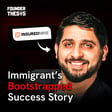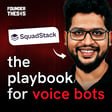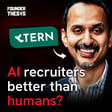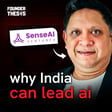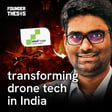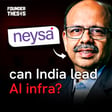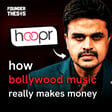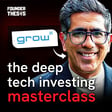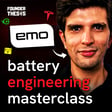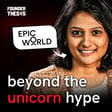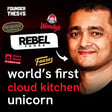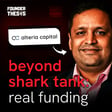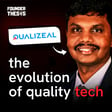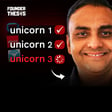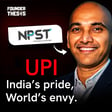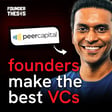Become a Creator today!Start creating today - Share your story with the world!
Start for free
00:00:00
00:00:01

Aggregating supply and demand of logistics | Gaurav Mangla @ Pickrr
Pickrr has built an asset-light logistics platform that aggregates logistics service providers and companies seeking logistics services. Gaurav is a serial entrepreneur whose first venture was in the B2B Saas space. He talks about the lessons from his decade-long journey as an entrepreneur and about selling Pickrr to the logistics unicorn Shiprocket for a cool $200 mn.
Insights shared:-
- Building Asset Light business models
- The business case for aggregation platforms
- GTM and scale-up of an enterprise product
- How to think about acquisition offers
For bonus content related to the episode, head over to ThePodium.substack.com
Transcript
Introduction and Background
00:00:00
Speaker
Hi everyone, Mysil Gauram, I am the founder and CEO of Ticker.
Disruption in Business Models
00:00:16
Speaker
There are two broad themes of how startups disrupt traditional businesses. They either take the path of disintermediation or they take the path of intermediation. D2C brands like Mama Earth or BOT are taking the path of disintermediation. They are removing middlemen and want to sell directly to the customer. On the other hand, a company like Zomato is following the path of intermediation.
00:00:40
Speaker
It has inserted itself as a middleman between consumers and restaurants. You might think that intermediation is bad, but intermediaries exist because they add value. No one is going to go back to ordering food by calling restaurants because Zomato does such a fabulous job of
Innovation in Intermediation
00:00:56
Speaker
it. In the logistics space, Picker is doing something similar.
00:01:00
Speaker
They have built a satellite logistics platform which aggregates logistics service providers and companies seeking logistics services. In this episode of the Founder Thesis Podcast, your host Akshay Dutt talks to Gaurav Mangla, the co-founder of Pika.
Entrepreneurial Journey and Success
00:01:14
Speaker
Gaurav is a serial entrepreneur whose first venture was in the B2B SaaS space and in this candid conversation, he talks about his lessons from his decade-long journey as an entrepreneur and about selling Pika to the logistics unicorn Ship Rocket for a cool $200 million.
00:01:29
Speaker
Stay tuned and subscribe to the Founder Thesis Podcast and any audio streaming platform to learn from some of the smartest entrepreneurs in the country.
00:01:46
Speaker
I left IIT Guwahati. In IIT Guwahati II, I did two intern trips. One was a research internship in Europe that showed me that I have not a material for research. Then the second internship was an internship at a startup, which was a three-year-old startup at that point of time. I was grinding. When I joined there as an intern, I used to work with a 10-15 or people team.
00:02:08
Speaker
They were, I think, only 10-16-odd people in that startup at that stage. So, saw a lot of flesh, a lot of innovation, a lot of hard work, kind of stuff there. So that was first exposure to a startup ecosystem. And then when I got into consulting in Bangalore, a lot of friends around me used to work at places like Flipkart, which was kind of a startup at that point of time. Some other places also where there was startup, which I was getting into. And I myself thought of, I had to work at a startup. I can't work into a big company.
00:02:37
Speaker
And then I saw the exit of that consulting of me where I was working. That was also a startup would be, but that got acquired somewhere. So there was a lot of things around me. And then eventually me and two of my friends, in fact, three of my friends, like all four of us decided to start something of our own. And then we'll figure out what to do, what not to do.
00:02:58
Speaker
This was your college friends who joined you? Yeah, two IIT Guwahati college friends and one was a person who joined with me who is the founder of Vikkaraes. We both joined that consulting group around the same time. So you became a friend there.
00:03:15
Speaker
Yeah. So what did you identify as the area to build your startup in? See, at that point of time, I was found programming. I wanted to land in the programming job and I was preparing and I saw a lot of platforms where, you know, you can code and you can combine. There was a lot of good innovation stuff.
00:03:33
Speaker
And we felt that let's take these offline interviews to online rather than just a lot because we felt that somehow physically appearing for an interview is a big daunting task and there are a lot of nuances to it. And there can be a good opportunity, not only just to interview, but to teach people as they're programming. And way back in this was, I think, November, December, just five to six months into the job, we started thinking around this.
00:03:58
Speaker
And we thought that let's make something for fun. It was not a startup, actually. It was like, let's make a product, something for fun. We made it in the odd months. And then through some friend circles, we did some pilots in colleges where we organized certain hackathons and ran those hackathons of our MVP product, which was just made part-time. And after three to four months of those validations, we thought that now, I think in July of West 2014,
00:04:24
Speaker
Without that, now the time has come that we need to go full-time and launch this product in the market. What was the product you learnt to help me understand? It was a product which was half-window, which appeared to be a video conferencing. Half-window was a code compiler, like a Google Doc, where multiple people can code and compile the same code. And I write that code in 14 languages. Okay.
00:04:46
Speaker
And by language here, you're not talking Hindi, English, you're talking like Python. Yeah, yeah. Python, C, C plus Java, like almost every famous language, whatever you want to port, you can port in that. Okay.
00:05:03
Speaker
This was like you thought of it as what like a way for reward teams to work together. What did you think of the product? What was the use case? So first two use cases were taking programming interviews and teaching people programming. And the first thing that can fit into gigs for gigs kind of products that can fit into hacker ranks, hacker kind of products. So it was that kind of a product at that point of time, which was not there. So that product was I would say two year early into the market. Later on, a lot of folks came around and launched such products.
00:05:33
Speaker
I was lucky to get that product adopted not only in India and outside India as well. In London, I remember a few of our clients used it for taking interviews in a university in London. And then some other places also in Europe, it got used. And in India, also in various IITs, it got used. So we got a decent adoption, but the pricing and mechanism of all those stuff was not working out. What was your go-to-bucket? How did you get this adoption? Was it just word of mouth, people discovery?
00:06:03
Speaker
Network effect, I would say we had a lot of friends who used to work in companies and a lot of our seniors like when this is a good thing that happens in every hostel that if you see if you engage with almost three years senior to you guys so those guys in two to three years in job also will be much more senior at some places.
00:06:22
Speaker
Engaging college network, asking people then to, you know, engaging some companies also, and then going to, in Bangalore, it's very easy to access any startup, go to places like NASFOM and all, accessing those places. We took ourselves, first office, we went to NASFOM only that, you know, we'll sit with all our clients one day, and then, okay, everyone, like we bought Zoom cars from NASFOM, we got a lot of other clients, then we got...
00:06:48
Speaker
You were incubated by Nazcom or you took a place on rent there? It was on rent only at that point of time. We didn't receive any funding from Nazcom. But the first angel round that happened was through a lot of folks from Nazcom. But eventually, before that angel round put over, we eventually gave up on the business to be really flat. Okay. Tell me, what made you realize that it doesn't have legs?
00:07:16
Speaker
You must have felt, Nick, what was the... See, a lot of people, see, even today also, apart from North Korea, no such hotel has really kicked off, really well in India. To kick it off, you have to have a global access. Second, the product, like people were evaluating folks, but eventually there was a higher opportunity there. Someone was getting a job of 30 lakhs through our hotel and we were getting 10 rupees.
00:07:38
Speaker
And how much when you're searching the risk can happen on like this. And then the India was very much price for it just as well. I would say he presented the failure would be our mindset. 20% would be external factors, but that is something that to be learned in the very start that.
00:07:55
Speaker
We don't need to give up so easily. Like today also, no other portal has succeeded that much in the market, even after eight years. So it's not something that I feel good about him, but something that we made a product, we made that product with a lot of heart. And now it just stands something that we built and gives us the confidence for me that you can build an epic bike. That's all about it. So we gave it to a company. Acquired your IP acquisition.
00:08:25
Speaker
Yeah. They just required a product and you were also there, but then we thought that you start something again. We come to the next thing you started. You said 80% was your fault. What do you mean by that? Did you not price it well or did you not raise money and then spend money to grow it? Because you need money to grow. Money was not a challenge there because there was an angel round that was happening. I think it was something that all four of us were not aligned with to scale with.
00:08:54
Speaker
Okay. You all had different views on what it was to become that. And we gave up quickly. So that was, there was some learnings and those were majorly cultural. And all that product was generating money. It was generating 10 or live rupees monthly, the venue. And we had more deal. We only four people were there. All four founders, all four of us, all three of us used to code and one one used to sell.
00:09:21
Speaker
Selling was also getting scaled by network effect. We had a lot of inbounds. People expected us to do sourcing as well. People expected us to do screening as well. So now we see a lot of interview platforms coming up where some other guys isn't reviewing outside the universe of the company.
00:09:41
Speaker
So, there have been a lot of things coming up in hiring, but personally, what I have seen is, apart from marketing.com, there has been no significant scale-up anywhere else on the portal side of things, at least. What was the disconnect between the four of you?
00:09:57
Speaker
There was no such disconnect. It was mainly like that we all had sessions that we should do something else rather than wait. So eventually out four people, three people were in the next thing. One guy, he took a job in Facebook and went outside India, but three are still in the next instinct of the startup. So there was no cultural difference between all four of them. Understanding that we might have ended in the wrong domain that might have been a wrong call, but it is passed now. So that's what under the bridge.
00:10:24
Speaker
Okay, so then what was the next thing you decided to do, the three of you?
00:10:30
Speaker
So we thought that we looked after a lot of places. We thought of starting something, a lot of stuff. One day we thought that logistics is a space which has big legs and we want to do something very significant and we want to pick up a bigger problem. So let's solve a 2-hour 3-hour delivery solution for Cal India. And this was the step we took in 2015, June. And within 15 days, we lost people. We called another guy.
00:10:59
Speaker
Yeah, well, in 2015, was it a thing? Because all these hyper-local startups are coming in now, right? What was the use case for 2R3R2? In 2015, it was a thing. It was like, there was Node Runner, there was Tanya, they were picking, they were almost shifting what startups started simultaneously. We were the 22nd, 3rd month.
00:11:24
Speaker
But three years from back then, like in 2018, only 2.3 out of 23 survived. And we were one of those 23 survived. And now also only those three survived. BigQuery is running something else, some other guys running something else. So those companies who were very much unit economics focused or who were not willing to just bond the money, have survived and have scaled into different domains, but into logistics only.
00:11:50
Speaker
So this is how on days, you cannot determine what will be your startup will look like five years on the line. And if similar grind you would have done in optimized bits, that might also have shaped on something else, but suck point flip thing that happens. And sometimes it is a learning only left out of it. So you wanted to do that roadrunner shadow facts model where you would have these gig workers who would govern the platform and accept transportation, pick up, drop assignments. That was the plan.
00:12:21
Speaker
Yeah, that was the plan. So we unrolled those gig workers on our payroll at that point of time. On your payroll? Not as gig workers. Give them fixed salary. Yeah, no. So we used to give them fixed salary apart from that transaction process for petrol and bike repair and all those kind of stuff as well. How did you source these riders?
00:12:45
Speaker
But there were a lot of agencies at that point of time. So I would say it was not a problem. Main problem was managing their compensation because market was very competitive. Everybody needed delivery boys. So delivery boys used to hire in 15,000. You might end up paying them 25,000 if you retain them for a year. Okay. Because of incentives and all of that.
00:13:06
Speaker
Not only just incentives, there was crazy money flowing into the ecosystem. If someone raises their pay, we can even next day hire. Then there were companies like delivery and all also, who were also expanding at that point of time. So every logistics company, every hyper-local company, everyone needed delivery boys. I really thought that every company needed delivery boys. Okay. Okay. And what kind of, who were your early customers? Was it like restaurants? Yeah, it was 1MG. It was Snapdeal.
00:13:35
Speaker
of few restaurants as well in South Delhi. Then we had some e-commerce customers as well who were running their own Nengar kind of stores. Then some in Shapurjat and there were big names you would recognize would be Snapdeal one energy.
00:13:49
Speaker
And first app deal, 1Mg, you were doing what? Like last mile or was it like 5 mile? Yeah, yeah. For snap, for snap, we were delivering to our delivery. For 1Mg also, we were doing it for daily MCR. Like same to delivery, not to our delivery. Wow. Okay. So then what? You eventually pivoted away from that model. So what was the realization that, what was that point of realization when you realized that we need to pivot?
00:14:17
Speaker
See, that model getting business is relatively easy. Sustaining the business is the toughest part. And you need a huge scale to sustain and to bond such kind of a mechanism, bond such kind of money. Like fulfilling the orders, like you can get order volumes, but to fulfill orders.
00:14:38
Speaker
Eventually, the cost to the venue mechanism was not building up. Unit economics was not working out really well. People were, if you go to small players, they would pay you 20-25 rupees per delivery. If you go to medium-sized players, they can pay you 20 rupees per delivery. They were not paying premium for two-hour delivery. People assumed that people wanted a two-to-three-hour delivery, but they were paying like a same-day or negative-day delivery.
00:15:03
Speaker
And apart from that, eventually it boils down to math that we are earning 20 rupees and we are spending 28 rupees. That kind of a, it's like a six to eight rupees loss per order. So then eventually we raised one angel round for a 1.26 crore and which got over. This was in, I think we started in June, July and the round happened somewhere around in October 2015, November 2015. Yeah. And we were able, we almost got finished in like
00:15:31
Speaker
April 2016, our money got over, which we raised, but business was still there and then we had a survival round in August, I think in August 2016 of another 1.1 crore. So total 2.35 crore and then after that next survival round, the first thing we did was we removed every operational capability that we had.
00:15:53
Speaker
Yeah. You realize that in a constant race to raise money to manage your costs and meet your payroll and all that. So you needed to figure out a way to not be in that constant race because every order you were losing money.
00:16:08
Speaker
Yeah. So we thought of how in the same business, we can make money. So first of all, what we thought was that it can be outsourced our first mile. If you are spending 8 rupees on first mile, you can be reduced to 3 or 4 rupees. Someone else who has this network can bear this cost for us. Then who can lose the last mile? Just define this. What is first mile and what is last mile?
00:16:30
Speaker
First mail is picking from the vendor's warehouse and bringing it to some standard warehouse. It can be a picker or it can be someone else's well. Last mail is someone who picks from Hub's warehouse and the delivery has to operate in Godong or someone picking from Godong and delivering it to the last client.
00:16:49
Speaker
And middle-mile is from your customer doorstep. Middle-mile is from the pickup warehouse, from the shipment got picked up from there to getting it to the last-mile warehouse. So, this middle-mile was not that of things if you were doing a good job, to good job, for delivery. But it was a thing if you're doing from good job to, you know, noida kind of delivery. From, you know, for delivery to a non-delic kind of delivery.
00:17:15
Speaker
So, we thought that, what are these points? We thought of it very efficiently as well, mathematically as well. And we figured out there are certain methods like franchisees of various kore company or some kirana stores guys who have some manpower. They have a bandwidth. They already sustaining those people on the fake salary thing. And now just we can utilize their vehicle, their manpower to get this thing played out in daily NCR.
00:17:40
Speaker
So that thing got worked out for us. And eventually we were able to come to a breakeven kind of a situation in one order. And then we realized that what did this setup look like? So basically you went to an asset like mode where you decided to plug in vendors for each step of the logistics process.
00:18:00
Speaker
Yeah. And variableize your costs. So you no longer have a payroll of riders that you have to meet every month, but you have only variable costs where you pay per transaction, like per pick up or per drop. So what did this look like? Just help me understand what kind of people.
00:18:16
Speaker
Yeah, first pivot was that people like shop owners, they were doing the pickups for us from the warehouses of all our clients. Then they were bringing those parcels to their own warehouses. And then there was that same vendor delivering it if it's in the Bhutan area, if it's in the same city.
00:18:33
Speaker
If it's in some other city, then some other vendor, some other city should do, we used to do a pickup from their warehouse and deliver it there. So eventually we made all these transactions completely fulfilled through Picker. We monetized as well as we saw the training piece of it and monitoring piece of it of this entire process. And after another, like in November, 2016, we were able to scale it to this model.
00:18:59
Speaker
And how were you stabilizing quality and all that? Like you had an app for the vendors who were using it. We had a vendor app, we had an internal app, we have vendor managers, those kinds of apps as well. And on every cluster, they were cluster managers and pickers who were absorbing what's happening in those clusters. And how the Intra clusters are playing out. Intra cluster is very easy to manage, but Intra cluster playing out was another nuance.
00:19:27
Speaker
And then there was COD as well. There was a lot of cash getting exchanged between those vendors. Securing that cash was also another learning. Then there were returns as well when you do a COD shipment. Securing those returns and getting them delivered back to customers was another challenge. So we got into this model and we ran it for almost a year and a half. And then you were essentially
00:19:51
Speaker
a software product at that stage. You were building software which would allocate work. A customer orders a drop and the software will see what's the customer location, what is the drop location. Then it would route that order to somebody to pick up from customer point to warehouse and then it would route it from warehouse to
00:20:11
Speaker
the drop point, so that your efforts were essentially on building that software to manage this whole process? Yeah, so there were two ways to look at it. In Germany, what you are saying is right. We were internally a complete software product. Only until today, we are internally a software product. For our customers, we were a courier company. We were delivering partners only. We never told that we are using X network, Y network, Z network. It's our network.
00:20:38
Speaker
We are responsible for this. So if anything goes wrong in the top middle mile, last mile, any state of the parcel being active, we are responsible for it. If anything goes good, we are responsible for it. So eventually we planned out like this way. We charged like a career company and internally we managed our cost. So in a year or so, we became a breakeven in that model. We reached to almost three and a half crore a month.
00:21:07
Speaker
We were not able to win large customers because our costing was somewhere around 2022 rupees and since we had very limited money, we couldn't afford to burn money. So we thought of that.
00:21:20
Speaker
Main thing for us, main vision for us to validate whether this will work out or not. This is also sometimes very important. You can't just blindly go and you scale something. So we needed that validation whether this is the business to be in, this is the business to scale or third is, are we the right people to scale this business? So that learning also came a lot and then we also
00:21:42
Speaker
Try doing warehousing as well for a year or so. You did tell me what kind of customers you had. These were like D2C brands. These customers were mainly small D2C brands or shop owners or a franchisee store delivering parcels of C2C people.
00:22:01
Speaker
like customer to customer, like whenever you or me, people like you or me, go to some franchise and give him some packet and he gets it delivered through group. So business was a small bomb of shops who are delivering on their own port and or who are selling on a certain call center kind of analyst. That time WhatsApp sending was also not there. Third was like TV shopping was there. Like at that point of time they would lock back their TV shopping. So those TV shopping guys, these three, four kinds of customers were there. Okay. Okay.
00:22:30
Speaker
Got it. Okay. And so you were saying you tried warehousing warehousing. The next step was, can we manage the warehouse of these clients? Because these are very small clients and they don't, they will not be able to do proper packaging. They will not be able to do proper dispatch. They're just randomly packaging things. They are incurring losses due to breaking of products or sending wrong products or sending something else. There are a lot of inefficiencies. So we thought of getting into warehouse business for these guys as well.
00:22:59
Speaker
And that point of time, we also envisioned, can we get into an Amazon Prime kind of a business as well, store products at multiple locations and enable a quicker delivery rather than doing a three to six day kind of a delivery at that point of time. So we thought of a lot of stuff and then we decided, let's add this vertical to our current business, then getting into some parallel vertical.
00:23:21
Speaker
But eventually we did it for a year or so and it didn't make a lot of money. It, in fact, brought a lot of loss to us. So then we thought that let's not get into this. And without the time it was progressing. Help me understand the truth. What value are that warehousing function did? So without the warehousing function, the flow would be that.
00:23:40
Speaker
customer places and orders, then you pick up from customer's warehouse or shop and you directly drop it off to the drop point to the receiving customer. That was the flow. Yeah. That was the flow. You didn't have a warehouse of your own in the middle. Like we didn't have any warehouse. Yeah. Okay. Okay. So then you decided.
00:23:59
Speaker
Yeah, we decided to add warehouses. We partnered with certain vendors. We took spaces from them on rain. And then we started doing it for the same people, but we did it for a year or so. What would happen is that when a customer places a drop order, so you pick up from the customer's site, take it to a warehouse, and then it goes to the drop. No, no. We used to tell them that you are having these kind of orders in a month. Send this much inventory to our warehouse.
00:24:28
Speaker
And as soon as an order comes, our guys in the warehouse will purchase those persons. And then we used to give it to a person who will eventually deliver it. If it's an intra-city order, last mail vendor will come directly to our warehouse to deliver it. If it's an inter-city order, we used to give it to a cool day company from our warehouse.
00:24:47
Speaker
And then we all got a lot more customer and inventory sustained the same two and a half degree crore kind of a revenue business. And then again, but the thing was, this model was also not C11. It was again, cash burning as well as a lot of inefficiencies were there. What was the problem with it? Like the extra earning that you were getting was not helping you meet the expenses.
00:25:09
Speaker
Like your expenses would be rent and manpower when you run a warehouse. Right. Manpower, liability of that inventory, inefficiencies, loss, damage, everything was a higher thing only at that point of time. And we started getting courier companies also onboarded at that point of time. Then eventually... Was this a pricing problem? You didn't price it properly, the warehousing service?
00:25:34
Speaker
I would say every vendor that we had or every customer that we had at that point of time felt that their mother house was cheaper than warehouse managed buyers. So it was a sentiment plus pricing problem. They thought that why we are paying 10 rupees extra on a parcel when eventually we are earning a cost of two people in our warehouse whose salary are around $30,000 and eventually we are paying bigger $70,000, $80,000 a month.
00:26:02
Speaker
why I think that extra 30,000 cost. Okay. Okay. Okay. Got it. Got it. Yeah. Sorry. Yeah. Right. You finished your point. Like the value. Well, my point was the value that we should have brought at that point of time should have been even in production of articles or some faster delivery management was not returned. Like any COD parcel gets returned as well. No, I don't want this parcel.
00:26:31
Speaker
Customer refusal also is part of return. ODA is also part of return or some other nuance. So eventually, we were not able to deliver significant value to our customers as well. So we didn't have too much reason then we would have shown that you're spending this extra 40,000 rupees, but you are saving 4,000,000 rupees. So that wow, except that we were not able to generate out of the warehousing that if we were just getting losses on the liabilities and people started making money from us through our warehousing model.
00:27:03
Speaker
Yeah, it's like everybody used to race disputes and my parcel was broke, my parcel was lost. There were a lot of recon nuances start coming up. You mean reconciliation, like reconciling what the vendor sent you, like what the manufacturer sent you and what you are showing on your dashboard. And also we didn't build tech around it. We were managing it through a lot of manual processes. So there were certain inefficiencies. So now the call came.
00:27:30
Speaker
that whether we should build a tech around this business and scale this warehousing business or we should not do it until next we figure out the extract. So we thought that we will not do it until we figure out the extractor because if you would have made tech on it, you would have to deploy a tech team, hiring a tech team, maintaining a tech talent is even more costly, expensive and difficult in India.
00:27:50
Speaker
If tech also comes now, still, are we able to figure out the extractor that we wanted to distribute to our customers? Will our customers pay us 10 rupees rather than 5-6 rupees? Can we charge 20 rupees? We didn't answer those questions at that point of time. So far, you were only Delhi and Sian? Or were you Pan India? We were Pan India in 2016, in December. Okay.
00:28:19
Speaker
So you actually had warehouses in multiple cities? See warehousing thing we started only in Delhi, NCR, Bangalore, Jaipur and Mumbai. Delivering thing through multiple vendor we started in December 2016. And you were mostly doing intercity or like nearby, like short distance, say neither to not Delhi or within Gurgaon or within Bangalore.
00:28:43
Speaker
From 2016 June to December 2016, we were mainly 90% 95% doing nearby thing one day.
00:28:51
Speaker
From December 2016, we were delivering Pan India. So we had vendors who used to go to customer's warehouse, pick it up, bring it to their own warehouse, either hand it over to a local vendor who would deliver nearby things some vendors did themselves, some gave it to someone else to do it, or go to Faridabad to Noida, definitely someone else gave it to their warehouse to pick it up. Now for Pan India, Corel companies started coming to their warehouse to pick it up. We started contracting with Corel companies that we are your customers and you have to deal with us.
00:29:21
Speaker
We are not an aggregator. You have to pick from our warehouses. You don't have to pick directly from customers' warehouses. Till 2018, we went on to scale this model. The advantage of adding warehouses was that you added one more player in the ecosystem, which is a career company.
00:29:40
Speaker
Yeah. Yeah. And further for to manage our first mile, last mile vendors, they can also drop things at our warehouse rather than at their warehouse because there was another handshake on the liability thing. So now they were two legs of liability. We reduced it to one leg as well.
00:29:57
Speaker
In those warehouses, we were able to sort out way discrepancy as well. Now we know the actual way to the shipment, the other sending seller telling us. So there were some good factors, but some bad factors. And at that point of time, I would say we were not matured enough to deploy that kind of money or we didn't have that much money access. Further again, that answer to the question that can we stay in this model?
00:30:18
Speaker
came up perfectly. It was like some three and a half, four crore monthly revenue business is shaping up, which is on a yearly churn and retention growth and keeping all the sectors. We're able to sustain it on two and a half, three crores. In two and a half, three crores, you are able to make a 20% gross margin and you have a 40-50 lakh salary. So it's like a 10 lakh, 15 lakh monthly profitable business that is shaping up. And we ran this business like this for almost a year and a half.
00:30:46
Speaker
Till 2019 and I would say we ran it. And then we came up that we don't want to run this business traditionally. We want to make it into a big business. So we stopped all our bleeding accounts. Wherever in some accounts you are making money, in some accounts you are bleeding money. Then eventually, when you came to a crore and a half, I think around 2 world crores of sustainable revenue with a 25% kind of a gross margin.
00:31:14
Speaker
So we just corrected the business that we had. And then we thought that now we have tried a lot of stuff. We have seen e-commerce, we have seen warehousing, we have seen last mile, we have seen the connectivity vendors, we have seen packaging, we have seen almost everything around logistics except for the whole chip, whole storage.
00:31:30
Speaker
et cetera, those kinds of things. And we have done a lot of enterprises in our journey. We have done last night for big players. We have done this network thing that we were doing in between for some big players and not that big, but recently sized players. And then we also saw emergence of a lot of D2C that was shaping up.
00:31:51
Speaker
When we started in 1560, in that point of time, V2C was hardly 3-4% of the total e-commerce. But by 2019, they became somewhere around 12-15 odd% of the market, which was sizable. And everybody was thinking about opening their own brand.
00:32:06
Speaker
This was late 2019. And then we took a pause that all the same team we had, which we had in 2015, 16, 2019, all of us as a group decided that let's figure out what we have actually learned and where we failed in the last thing for years. And let's do a complete business model that now we will not touch any parcel. We will not do first mile also. We will just do proper aggregation. And we will do it for enterprises. We will not do it for
00:32:36
Speaker
small-scale players or I would say long-tail anyone who has one parcel a week. So we quantifiedly called it anyone who does above 3000 parcels a month is our customer and anyone below 3000 orders a month should not be our customer.
00:32:52
Speaker
If they come into our product, we will handle them the way we handle enterprises. But it will not be something like we don't want them to or themselves get onboarded. We don't want to do a sales or product thing with them. We will not want to give them a robust support. We will give them the support that we are building for enterprises. And let's go on and scale this business. And eventually we got into the model that we have today. And the starting point of this model was 2019 December.
00:33:19
Speaker
And what made you decide this cut off of 3000 orders a month? Like you saw that these are the profitable accounts.
00:33:29
Speaker
These are not just profitable accounts, these are high volume accounts. So when you are doing an aggregation thing, you have to balance your courier companies, your supply vendors. You have to give them enough volume so that you can get better pricing. So the larger customers will make lesser money, but with the volumes of those large customers, you will make more money in small customers.
00:33:50
Speaker
So like we had buckets of three to 10,000 and 10,000 plus customers. In 10,000 plus customers, we are making five, 6% margin. In three to 10,000 customers base, we were making almost into 20% margin. And we took all these data points from our learning that we had in like past four odd years of doing everything. So we thought that let's pick up and become an enterprise thing. And one question that I told you is very important for every entrepreneur to learn.
00:34:17
Speaker
Whether he or the founding team is the right team to scale this business apart. So we are very confident that as we can scale an enterprise business, we have demonstrated a survival on a decent, sizable business for almost four years without much money. And there were certain other learnings that we were operationally able to serve these clients. We know what these clients need. We know their ground operations. We know what is their expectation and how they are able to scale beyond the ecosystem of Amazon and Flipkart.
00:34:45
Speaker
So these were the cool deep diving things that we had. And in 2019, we thought that let's go all in. We have already missed it four years of thinking about what's happened and what should happen, what should not happen. Now it's enough is enough. This is the model that we will sell and we will go all in this. And then in three, four months. Had you been doing enterprise sales? Did you have a sales team because enterprise accounts means more sales effort, longer sales cycle and all that. So what do you get for that? Like pre-2019?
00:35:13
Speaker
It's like our founding team only, everybody became a salesman. When you are in four years figuring out things and talking to people, eventually you end up becoming a sales guy. Okay. And you said in 2019, you decided you did not want to have any touch point with the package. What does that mean? Like you wanted to eliminate all the... We want to eliminate warehousing. We want to eliminate all the middle mile, first mile, last mile vendors. Let's do a proper food with aggregation.
00:35:41
Speaker
Career guys will go to pick-ups or festivals, whereas they will only deliver it. We will just focus on allocating better career, delivering high performance, and giving deep dive analytics to the brand so that they can enhance their last-mile take. So there was a study in PTM that emerged that the majority of the e-commerce brands, NPS, is being driven by their last-mile.
00:36:03
Speaker
Like how the package reaches the customer, how quickly it reaches, how like the experience that you are able to give in your communication channels with the customer and you're giving clear visibility and also getting to know your customer well for any brand that was really important. So bringing, solving that service layer, so transferring anything from point A to point B is a commodity thing.
00:36:26
Speaker
But bringing a service over that commodity which can even better experience was something that we tried to solve at that point of time through aggregation only. So that was our first product.
00:36:36
Speaker
And in 2009, what do you start with that? Do you be aggregating multiple people? Would you be making a chain here? This vendor, this courier company does still here and then there's a handoff where the second employee company takes over? Or did you just do pure, like there are 10 courier companies which can do this entire transaction? Which of those 10 should I select for this?
00:36:57
Speaker
Yeah, we did a pure aggregation. Okay. So there would be just a single career company which would manage the whole thing, but you had algorithms to decide which career company each order should be allocated to. Yeah. So what we did was see from day zero, we had a thing that we will be the face of the customer.
00:37:13
Speaker
So again, we acted like a Poiret company. We sold a product like a Poiret company and eventually at the back end, we would deploy the best Poiret company to fulfill those orders. And the factors were the pricing expectation of customer, the lane delivery performance of the Poiret company in past 15 to 30 days. Also certain other dynamics that are, you know, this company is tech driven and gives proper communication, whether it is brand, whatever, as per the requirement of the brand, as per the
00:37:38
Speaker
You can say the heuristics of the logistics are required to scale that brand. We were able to customize the product and that became a very good thing for us. That became the USB-F picker. So a lot of anyone who was scaling in D2C brand used to come to us. People in the early stages also came to us, but we had a very bad experience with us because we were doing less than 3000 orders a month.
00:38:00
Speaker
So till 2020, December, we did only enterprises. And after that, we launched and now let's become a self-serve channel. And we started taking steps towards 500, 2000, and then eventually we served everyone from zero to two lap orders a month. In 2019, we had a checklist that what went wrong for us, what could have done in this model. Now we're pivoting to this model. What are the key areas that we can learn from market competition and all those things in middle list.
00:38:28
Speaker
We completely went on a pause mode on the business side for three months before COVID. And we were like solving that checklist for us. And after that, the COVID happened again, we got some extra time to solve for a checklist. And in 2020, June,
00:38:44
Speaker
I think, yeah, May and June first week, we started getting business back, but every competitor was the same standing line. And the pause that we took eventually helped us a lot. And again, we were from like almost a two crew to a zero kind of our business June. In July, we started with almost with a
00:39:03
Speaker
customer base, almost five weeks. We started somewhere around three and a half, four crore. By October, we gave came to a number of six and a half crores. And then by March, we came to a number of 11 and a half crores per month. Wow. That's massive growth. Okay. You said you had a checklist of things to fix. These fixes were like software fixes. What were these fixes? Yeah, some were fixes and some were bins. We did hand a product for this model entirely.
00:39:30
Speaker
So the sub bits got prioritized, fixes also happened in parallel. But that was the only thing that we were doing in those three, four months. What is the product? We didn't have plugins for various, you can say app stores or places where people build websites like Shopify, WooCommerce, Magento, OpenCAD, and all those kinds of stuff. We didn't have a lot of communication products. We didn't have customer facing analytics. We had a lot of analytics on our internal reports.
00:39:59
Speaker
So we automated every manual process that is there. And we also made every plugin compatible with our product or every place wherever sellers are dealing with orders compatible with Picker.
00:40:12
Speaker
those are the two major fixes, but after that they were like optimization and all those kinds of things. You're saying that one is you need to integrate with your customers through Shopify and WooCommerce and all these e-commerce tools which are used to build e-commerce platforms. All your customers were into e-commerce or did you also have say traditional businesses which may not be looking at e-commerce but which
00:40:33
Speaker
We didn't differentiate between traditional businesses or e-commerce businesses. We had both kinds of customers. For e-commerce businesses, those plugins were mandatory. That was one of the reasons we didn't have too many e-commerce customers into our aggregation.
00:40:50
Speaker
product initially. For traditional people, we need to give them a lot of tools so that they can upload orders, get everything in real time. What are they getting in the market and what can we surface to our product? Can we make it very easy for these guys without knowing anything? Just go and see a screen and do everything in minutes, then minutes to seconds. So these kinds of optimizations we solve for them as well.
00:41:11
Speaker
So there was a checklist of almost 100-plus things. Yeah, sorry, yeah, finish your thing. Additional businesses are like businesses, like people who are just running their parents' business in different areas of markets and have certain online orders as well. Some are fulfilling sell shipping orders of Amazon. Some are fulfilling from their warehouse to distributors, then distributors to retail. Then some people are getting orders through, you can say,
00:41:36
Speaker
multiple channels, like some are getting through apps like city mall, etc. Some are getting through Oda and some are getting through some TV shopping like Napton and all. So those kind of traditional vendors. Okay. So for these vendors, you had a way for them to upload a spreadsheet with the inner certain template. And so that would then be something.
00:41:57
Speaker
When I do the entire magic for them, they don't have to worry about shipping labels. They don't have to worry about core elevation. They don't have to worry about pickup scheduling. They don't have to worry about if a parcel gets rejected by a consumer or if it's not reaching the consumer. If there are certain hazards, everything gets automated through a streamlined workflow channel.
00:42:16
Speaker
What were those automations you built to make the logistics work? You said that you don't have to worry about sticking labels. How did you automate all of that? Or delivery failed and all of these things? We integrated almost 10 world companies and every company had their own advances. Every company had their own formats. So we were not offering these 10 companies select of it. We were offering like we are a core company.
00:42:41
Speaker
So upload order, we will allocate it to whoever you want. We will give you a single formatted shipping label. We will give you a single formatted manifest. We will display analytics in a single way and courier-wise way as well. That work all got used and how they all performed. Is our algorithm working good or bad? If we are able to do a performance amount. And for India also, we were able to give them that
00:43:05
Speaker
10 orders of yours were attempted today, 5 got delivered, 3 got rejected, 2 got failed. And these are the reasons. And we will take necessary steps if you want to add some things into your step dating or some instructions you want to add, just add both instructions as soon as the instructions went to Cori companies. And then we ensure that these workflows are actually there to work out. And NDR is non-delivered return, something like that. Yeah, non-delivery report.
00:43:30
Speaker
Non-delivery report. Did the courier companies integrate with you through APIs? Was it like the entire software integration with the courier companies? Some people had APIs at that point of time. Some don't. So, whoever was integrating with the API, they didn't think they did else. Well, you must give them Excel sheets every day. We had a team that was to coordinate between them. Okay. So, then the non-text having courier companies? Yeah.
00:44:00
Speaker
We went on the tech-savvy mode. 10% was on very operational heavy mode. But those operational heavy was many people heavy. It was like some support force used to manage it daily. As we moved on, we integrated. We went into deeper partnerships with these query companies. We helped everyone. We need these kinds of parameters. We need these kinds of workflows. And as our business grew, every query company started giving us all the kind of tech requirements that we needed.
00:44:27
Speaker
How did you make the experience better for a customer? Say you said returns at an example. There are a lot of areas where some people feel that this business is easy. Like almost lots of people have tried doing this business, only 2-3 people have succeeded. So one quantified way of measuring success in this business is if customers, when they do directly or when they deal with people, if they do COD, what's the percentage of delivery in COD?
00:44:50
Speaker
That was very high with picker and this was one of the key factors. People doing COD used to come to us. Whether you are loyal and trustworthy with COD, yes. Because everybody in picker, every customer or picker vouched for our COD parcels. Next thing was, if you work directly, are you able to deliver
00:45:11
Speaker
Like I said, there are multiple zones, like from Delhi to Bombay, like 90% of the persons are going into 48 hours, 72 hours, kind of a thing, or they are going traditionally 96 hours to 150 hours kind of a thing.
00:45:23
Speaker
Then we were able to allocate better 4 years because of our allocation engine and we were able to deliver faster. So that was another brand thing goes into that. The last mile, the end consumer believed that I have ordered so much rest for the place since it has reached quickly. Then the thing was your NPS. Since last mile experience, samples are NPS. So brands were working with Pickler. Is there NPS growing or not?
00:45:44
Speaker
So these were the key factors that we delivered, especially for the enterprise customers. And based on the performance, you were able to scale really heavily on there. And no Korea company, Korea companies earlier thought that we are helping them, we are the network channel later on, they went against us. No, even they were coming back to us only because whatever Korea companies has tried against us has not succeeded at all. You said Picker gave the best COD statistics. How?
00:46:09
Speaker
Was it simply by choice of career company? That's if I choose this career company, then it will shortly get delivered. Was it as simple as that? Or was other stuff in your workflow, which made COD successful? Yeah. First was this allocation thing. I'm changing this elevation. If today it's like at 2 PM, I'm allocating something to Blue Dog, but if 6 PM on the same lane, I'm allocating something to Express Bs. So being such dynamic in the end to it was one factor. The other factor was as soon as the parcel was reaching different stages,
00:46:39
Speaker
What changed between 2 p.m. and 6 p.m. that you would do? That, you know, whether that hub has become the last-mile hubs of BluDart entering certain other challenges or whether BluDart in Jambarand in last 24 to 48 hours has started going very low. There are certain outliers in their delivery performance of COD or they are running short of some hubs, if there is some throttling in some hubs, if there is some other challenge expected. So that was 90% tech and 10% control as well.
00:47:06
Speaker
Some people used to see certain mechanisms or certain inputs. That was really valuable. Since you were a 30-40 people company, you could afford to do that. Second was, as soon as the parcel was placed, picking it up early. Because if you are not able to pick up those parcels in the correct timeline, if you are not able to dispatch those parcels on the same day,
00:47:28
Speaker
Then, losing one day in between could trigger an 8-10% reduction in delivery. Because what we incurred was the kind of demand that our sellers incurred was impulse buying. And in impulse buying, the faster you reach, the better you deliver. These kinds of different insights we had from our previous learnings. Third was, as soon as the parcel was getting failed, back in delivery, we were saying that the parcel could not be delivered. These are the reasons. And in 2020, we used to deliver SMS.
00:47:57
Speaker
to end consumer that, you know, delivery boy saying this, if you agree, then it's okay. If you don't, then please register. And we used to connect NDR directly from the end consumers. And we used to get it from our customers as well. The fourth point was, people who didn't responded on those SMS, since only, you know, 20 odd percent people used to respond. But the 80% odds folks.
00:48:18
Speaker
We used to tell our customers that we have to act in like another 24 to 48 hours, we used to push them. Or in some cases, we also used to do calling for them and you charge them for those calling things. And then we ensured with coded companies that you have to deliver these orders today. These are high priority orders. If you don't deliver these orders, your allocation preference will be reduced.
00:48:41
Speaker
So this thing can also be at 2 p.m. to 6 p.m. day. That at 2 p.m. we incurred in the morning slots that Blue Dart is not able to deliver high-end C parcels. So we might have to reduce their load a bit. Okay, amazing. There were loads of other nuances as well around this. So part of it was the pressure that you could exert.
00:49:01
Speaker
by saying that your rating will go down if you are not meeting these performance parameters. Part of it was also figuring out who can handle it fastest. Different players would be best equipped to handle a certain location, a certain time of day, and so on and so forth. That was clearly a managed experience. We used to literally ensure that
00:49:28
Speaker
Everything that is getting lost is reported faster. Everything that will be delayed, that will not have, you know, will not be able to influence anything in that being used to communicate and then keeping a good communication between brand and consumer. These were the three other factors where we thought and apart from that, managing this whole experience and synchronizing all the platforms.
00:49:50
Speaker
Like if the client is using XPartner over Shopify, that XPartner also needed to know, pick an edit to know, client needed to know, Shopify needed to know the entire lifecycle. So manage that entireization stuff across all platforms real time. So these were a certain other wow factor which really helped us. And like if customer could log into that D2C Brands website and see the progress of the delivery and... Yeah, yeah.
00:50:15
Speaker
Yeah, if there is a delay, that delay gets reported in two minutes to the end consumer. If there is an India that gets reported in less than five minutes to the consumer. Amazing. And how did you improve the last mile experience? Because you said that the NPS of the brand would increase if the customer had a good delivery experience. How would you ensure that the person doing the delivery is giving a good experience?
00:50:40
Speaker
It's not just about the person. For the end consumer, it's majority the brand only. And if the person is doing certain long things, then end consumers can report to us and we will take actions via core companies. The part from that one piece was communication, which I've already demonstrated. The other piece was quicker deliveries. If we are dealing with, we can say,
00:51:03
Speaker
7 Korea partners. They were 12 actually. Out of those 7, 3, we know that all 7 can deliver this parcel. And in all 7, we would incur X1, X2, X3, 3 kinds of cost.
00:51:15
Speaker
But X1 is the most expensive, X3 is the cheapest. So ours, we willingly used to compromise our gross margin and annotate it to X1. So that it reaches faster, it reaches through the rest mechanism and we used to bear that premium of better delivery experience kind of thing. And apart from that, it was mainly delivering this magic that sometime people used to get shipments from Delhi to also in less than two days.
00:51:41
Speaker
And then we used to observe that now this is happening, whether this courier, which was not premium, but it is cheaper one, but still they are also able to deliver in, let's say, 1000 pink quotes out of 7000, then prioritize these 1000 pink quotes. So we used to offer the best flavor of all courier companies in a single offering of pictures.
00:52:03
Speaker
And then supporting all these workflows, we had with every career, there was a single member of our team who was to observe all their workflows, suggest workflows and push for a company or student to adjust in whatever way they can to deliver a good experience to pick up. And apart from that, there are a lot of disputes and recon challenges with brands shared since the last five companies. So we had a very streamlined way of handling those things, especially for the enterprises. I'll give you some examples of this. So what are these disputes? So one example would be the way the dispute came.
00:52:36
Speaker
And sometimes it's two-way, like, because weight is something which is very, very much related to pricing. So, in Korea, Communist pricing happens per weight slab. So, it's a way of making money for companies as well. It's a way of saving money for their employees.
00:52:51
Speaker
Sellers as well, because seller wants everything to go in 500p now, which is practically not feasible. So bridging this gap was another product that we developed. We used to get it through sorter images where there is no sorter images used to go by grain. These kinds of products are getting packaged in this stuff. And if there are certain anomalies that you're shipping in a small face cream, in a big box,
00:53:13
Speaker
which is volumetrically two and a half pages, then highlighting such problems to brands that you don't need to ship in such heavy boxes, you will incur five times extra cost what you are incurring today. So these were other logistical problems we figured out and we solved for enterprises, not completely, but to the extent possible, we tried solving it.
00:53:32
Speaker
Why you the communication layer with customers about delivery updates and all like once somebody interacts with Picker, then all customer SMS's, et cetera, not the app notification, but all the SMS's would be handled by Picker. Yeah. SMS, emails, and now WhatsApp has been.
00:53:49
Speaker
But I'll say Blue Dot also says SMS, so would a customer get two SMSs in such a case? No, first is like Blue Dot, first like as soon as the parcel is allocated to Blue Dot, Picker will send a message that from your xyz.com, this parcel has been allocated to Blue Dot, this is the tracking ID, then Picker would send DA messages.
00:54:08
Speaker
These are delayed, blue dot doesn't send those delay messages. Then, out for delivery message, blue dot will send, but we take permission from our sellers that do we also need to send or we have a configuration with blue dot that you don't send, only we will send. These such configurations were not available two, three years before, but they are available today. And these are part of, you can say, collaborations that we have done with the coret of names. We have helped them streamline such workflows on the support channel.
00:54:36
Speaker
Okay. Okay. Then the last thing, the main PS and PS kind of an SMS will be served by us. Yeah. If any promotion seller needs to do with those customers on the loyal steel feedback, those kind of SMS were sent by us. Yes. Someone complains, I had a poor delivery, then like giving them a coupon or something that you would have.
00:54:55
Speaker
Yeah. Okay. Okay. Okay. Tell me what your fund raise journey. You had raised about two and a half crores till 2019. So what after that? After that, we raised around, I think somewhere around December, 2020. And after that was when you were literally like doubling or tripling everyone post general.
00:55:17
Speaker
Money came to us in the summer round, almost got finalized in somewhere around August. So we raised the round and when we thought that in 2019, we were just figuring out how to scale up things and we'll go for an investment round as well. So we went for the investment round in June and...
00:55:32
Speaker
And by August, I think we had our first term sheet from Guild. And in another 10 odd days, we got another term sheet from Ovidya. And also we had four or five other term sheets. Finally, in September, all we finally the construct that we go with Guild and Ovidya. And we completed that entire process around somewhere around Diwali. And in December, firstly, we got the money.
00:55:55
Speaker
So, this was during lockdown when you were at zero revenue. Did you manage to get so many term sheets? See, in June, we were doing some revenue. Until May, we were at zero revenue. But the things that we promised them, the things that we showcased them, were like literally in the hindsight in July, August, September. So those three months, we were growing very heavily. Plus, we were able to develop whatever we promised. And also, we were able to envision next two years of ticker.
00:56:26
Speaker
Since we have reshaped the delivery part of it, like we started in 2015, next thing is we'll reshape the warehousing part of it. The next thing we will go into the deeper versions of the checkout. Then next thing is we will disrupt the traditional checkouts for any e-commerce player. So there was a lot of growth happening in the current scenario. There were a lot of future growth prospects and we were able to retain and hire good people.
00:57:04
Speaker
We were almost like any growth channel for any D2C. Emergence and growth channels for any D2C brand. We became like an operating system for them.
00:57:14
Speaker
This was one thing, D2C itself was growing. Now, in post-COVID, D2C contributed around 20% of the total horizontal, of the total 100% e-commerce business. Now, within the next 5 years, they have projected to be somewhere around 43% of this entire business cycle, of this entire business. So, this was a huge time.
00:57:34
Speaker
They liked the team. They liked the way that we grinded life over. We would have landed into fancy jobs or we would be sitting outside India or must be running something else. But we took a grind and sustained this business for more than five odd years.
00:57:51
Speaker
And then you were able to hire and retain good people and grow business. I think nothing else of VC needs on that domain. Further, it was becoming very much competitive. Our computer ship profit was also growing heavily. Tell me about some of these future looking pitches you had about transforming warehousing and checkouts.
00:58:10
Speaker
Can we get a 5-7 minute break? Sure. You were talking of some future looking stuff from warehousing and checkout experience. Tell me about that. Have you done anything on that so far? What was the plan there? See, now we had three kinds of customers. We had an enterprise customers, which we originally started with.
00:58:29
Speaker
Then we had mid-size customers. I would say I should define it in the way that 10,000 plus order value customer month and the other enterprise customers, closer to 10,000 were like mid-size customers and less than 1,000 orders a month were long-tail customers.
00:58:44
Speaker
So we came to a customer base of almost, you can say, 5,000 odds by March 2021. And at that point of time, more than 70% of the business was driven by enterprise customers, 20% by mid-size customers, and 10% by long-term customers.
00:59:01
Speaker
So long-term customers and mid-size customers weren't necessary for us. But now the core companies have also evolved after collaborating and building a lot of stuff. So we face a lot of direct and enterprise customers that they might go directly with the core account.
00:59:15
Speaker
Then we thought that how we can allow these customers to be competitive in the market since D2C became a thing and everybody was opening up ranks. So now, if one branch succeeds, then there are 100-order replicas of the same brand with some other brand. So how can they differentiate themselves? How can they be ahead of people like Amazon and Flipkart in the market as well? And why people like us, then consumers purchase from them in this competitive market?
00:59:42
Speaker
So for that, we thought of looking warehousing at a very different lens. We thought that let's launch a SaaS version of Amazon Prime kind of a thing, where every parcel is delivered to the end consumer in less than 48 hours. And also plugged with certain local vendors like we did in our earlier model and ensured same delivery in some lanes possible.
01:00:03
Speaker
like Delhi, Jeff over to Mumbai or some other thing. Same thing, exit delivery. Just to solve a faster delivery thing. So with faster delivery, like I told you get to optimize returns, you are able to build a better brand name and also solve on the cost rate. Delhi to Bombay delivery through a normal friend cost you somewhere around 40. But on this warehousing thing, it will cost you somewhere around 25 to 30 because it will be dispatched from Mumbai only.
01:00:35
Speaker
You will send 100 pieces in advance because you predict I will have 100 deliveries this month. So you save that cost. Yeah. Okay. So when.
01:00:46
Speaker
And now we are doing close to 7.5 crore per vision in this model itself. So this model is relatively scaled up. And in 2021, we did our next series B round as well. That happened purely through Inbound. We got a lot of requests of Inbound in our series B round as well.
01:01:04
Speaker
capitalized some of the large-scale funds in the series around and it happened to be somewhere around $12 million. The money we got was post-COVID somewhere around in August or July and 2021, but it happened there. And then on the other front days, we thought that let's solve the checkout experience. In the checkout, if you know the end customer, show his RTO score to the two-hour customers that this person will accept only two orders out of 10.
01:01:29
Speaker
or auto-populating that we're taking is concerned that now people will not have to type addresses. Now, since we have delivered to millions of customers, people know our brand, take our brand and showcase certain trust loyalty factor through these brands. And apart from giving a unified payment experience, give a UBI handle to solve for faster prepared statements and all, and then integrate all the payment gateways. So very much we'll say,
01:01:54
Speaker
Checkout, NUS, warehousing, shipping, the whole package that we were able to act like an operating system for any D2C grad. So this was the vision and we are still solving this vision. Checkout, we are very nascent. We have, but we have done close to 15 kG of GMB through our checkout model in a month now.
01:02:12
Speaker
So doing good progress on all the fronts and then later we launched it for cross-water thing as well like shipping parcels outside India and going forward and figure out how to enable sales also outside India for these D2C plants. So these were the things and then in December on we went for the series C now.
01:02:30
Speaker
That was the $60 million round. That also got almost unfilled somewhere around March. And post-March, we sold the complete ship out there. Wow. 60, 60, 60 million. Yeah. Yeah. $60 million. Wow. Amazing. Okay. So with so much money in the back, like 60 million round you raised, why did you sell?
01:02:49
Speaker
60 million round we actually let go. We sold it in between only the kind of valuation that we were getting around 60 million. This offer was even better. And thicker plus ship rocket, see ship rocket raised to 100 million, we raised 60 million. We would have burned the same money on the same customers. This entire 260 billion. So we thought of that together we'll build a better ecosystem, we'll build a product faster and we will capitalise this market more. Because between us, there was too much competition and we were shedding out a lot of gross margin in between.
01:03:19
Speaker
Okay, so in a way it gives you more power over the supply which is Korea companies because now you're not competing with each other to retain Korean companies and Similarly for I guess customers still have a lot of options but for Korean companies, then you become a dominant source of business Yeah, yeah Okay, amazing
01:03:44
Speaker
I just want to understand how you felt about selling. I know that it's hard for founders who built something and you really struggled for those five years. Like how did you feel about selling? Were you happy at the outcome? Was it a bit of reluctance? You did it. See, the need to sell becomes a key when you take certain decisions. So we were not selling because we were struggling. We sold because it made a lot of sense for the ecosystem and for us as well. And financially also the offer was very lucrative. Okay.
01:04:13
Speaker
Yeah, and it was a mix of cash and equity, only cash. Yeah, it was majorly cash, some equity for that equity of ship rocket also and the whole combined ship rocket made a lot of sense.
01:04:26
Speaker
But now, isn't there so much redundancy? Everything that you are doing, say, Procreate would also be doing, right? Like, what are those synergies in which you are doing different things and they are doing different things? Is there any such thing? We are building faster from pickup. We are doing some part of the warehousing. We are doing them majorly, focusing on the enterprise business.
01:04:46
Speaker
Figuring out growth in the long-till business of FARS. And ship rocket is mainly focusing in some other tech products. They are focusing on building certain other areas where they are not focusing. They are focusing mainly on one of the areas the ship rocket takes, the cross-water thing. They are completely doing that.
01:05:03
Speaker
And apart from that, we have distributed some part of the business to them and they have given some part of our business to us. So without losing people's care, we are able to scale with less redundancy. See, redundancy will always be there, but at this point of time, it is generating money. No one cares. When there is less, it generates money.
01:05:19
Speaker
Help me understand what is Shiprockets profile? Your profile is you are focused on enterprise customers, majorly. What is Shiprockets profile? What is their product? We do the exactly same business, but they have built the product mainly for the long-term. Now they have extended the enterprise. We started with enterprises, then we extended to long-term. When I saw checkout, they were also doing some part. We were ahead there. So that goodness came to us. We were housing, they were ahead. So we gave the majority to them.
01:05:45
Speaker
cross-border, they were ahead. We gave the contact cross-border business to them. So it's like a synergetic way. And most of all people in this acquisition merger, the management teams are synergizing daily. So that is also working daily as app position for the entire world.
01:06:00
Speaker
Okay, amazing. I would understand this checkout part a bit more. Do you offer intelligence around, say some pin codes might have high probability of fraud or when someone puts in an address and you know that this address, there is frequently a non-delivery happening or there is a fraud happening or there's a return happening and so on and so forth.
01:06:18
Speaker
of such intelligences. Plus you just put your phone number, we'll show you a pie. This is where you have ordered and somewhere it was returned, somewhere it was delivered. We will give you extra loyalty points so you can get discounts. We will also give you speed options that you can get this order in seven days, five days, two days, or same day as well. With different costing or different discounts. Yeah, different costing.
01:06:44
Speaker
Okay. Amazing. So for the customer, they didn't become more like an Amazon experience because he just has to put in his phone. Now he doesn't have to feed in his address, which is very painful to do that. You go. There are returns because people generally buy some multiple places, whichever faster was there.
01:07:02
Speaker
Or second is, people don't trust that website. People trust Amazon with a card. Third is, any D2C brand is not able to offer such kind of a brand experience like what all they do. So we are solving all those things. How are D2C brands getting much more lucrative to the consumer? So you're spending one lakh rupees and getting 500 people to transact. Can you transact? Can you help around get them 1000 people to transact while spending the same one lakh rupees? So better conversion is also one of the key areas of checkout.
01:07:31
Speaker
Does a consumer also get that assurance that my returns and all are going to be hassle-free if it is powered by pickle, something like that? Is it why I prefer Amazon, for example, is because I know if anything goes wrong, Amazon will just pick it up, no questions asked. It's very easy to do returns. Yeah. So the brand name for that product is Fasto and we are promising better refunds and faster refunds and as soon as he returns.
01:08:00
Speaker
So you're helping build a layer of trust for D2C brands as far as logistics goes.
01:08:07
Speaker
Yeah. Amazing. So going forward, will you merge into one product or will they continue to be two separate products of ship rocket and picker? See, we are not yet figuring out any answer to this question for at least another year or so. It seems like they're putting products, but one day or so, it might happen or might not. So right now we are signaling the right data points to take such roles. But as a team, both picker and ship software team are now considered as one team.
01:08:36
Speaker
Okay. Amazing. And what about you personally? Are you looking to continue or are you now soon going to look for your next adventure? If I'm now, I'm willing to continue only. I'm figuring out what all PCs where I can contribute better and faster.
01:08:52
Speaker
I'm thinking that let's see how time goes, how the equation goes and things goes on. Hopefully, I'm current till now, in the first four months, I am enjoying this merger. I'm seeing a lot of things getting like some expectations that we had that in your gross margin will improve, purchasing ideas will improve, customers will not size too much in front of the same customers. All those things have shaped out really well for me. So it's a good journey going on and hopefully, let's see how it feels. And that brings us to the end of this conversation.
01:09:21
Speaker
I want to ask you for a favor now. Did you like listening to the show? I'd love to hear your feedback about it. Do you have your own startup ideas? I'd love to hear them.
Engagement and Feedback
01:09:30
Speaker
Do you have questions for any of the guests that you heard about in the show? I'd love to get your questions and pass them on to the guests. Write to me at ad at the podium dot in. That's ad at t-h-e-p-o-d-i-u-m dot in.
